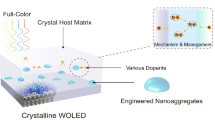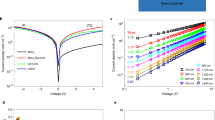Abstract
Since crystalline organic materials possess high carrier mobility, good thermal stability, and chemical stability, Crystalline organic light-emitting diodes (C-OLEDs) exhibit superior characteristics of low turn-on voltage, low operating voltage, high light output, high power efficiency, and low Joule heat loss, demonstrating the great potential of C-OLEDs in the OLED field. C-OLED, which consists of a crystalline host matrix (CHM) and “hot excitonic” nanoaggregates (HENA) sensitizer, is a newly proposed promising light-emitting structure. Compared to other crystalline OLEDs, the CHM-HENA OLED has a higher device efficiency owing to heterojunction effect between crystalline host matrix and “hot exciton” nanoaggregates. However, it is unknown how nanoaggregates affect the electron conductivity of devices. In this paper, we adjust the size of the nanoaggregates and examine the growth behavior of nanoaggregates. There is a critical value for the growth of PAC nanoaggregates when the nominal deposition thickness (NDT) of PAC nanoaggregates is between 0.8 and 1.0 nm. By investigating conductivity with metal-oxide-semiconductor (MOS) structure diodes, the size of nanoaggregates (NDT of approximately 0.8 nm) with the best electrical conductivity properties is found. The current of the CHM-HENA OLEDs with different NDT of PAC nanoaggregates and the corresponding the CHM-HENA MOS-structure diodes conductance follows the same trend. The results of this work will greatly assist the conductance study of CHM-HENA OLEDs.





Similar content being viewed by others
Data availability
Data (images and measurement files) supporting the findings of this study are available from the corresponding authors, Bo Yu and Feng Zhu, upon request.
References
J. Kido, M. Kimura, K. Nagai, Multilayer white light-emitting organic electroluminescent device. Science 267, 1332–1334 (1995)
S. Reineke, F. Lindner, G. Schwartz, N. Seidler, K. Walzer, B. Lüssem, K. Leo, White organic light-emitting diodes with fluorescent tube efficiency. Nature 459, 234–238 (2009)
V. Coropceanu, J. Cornil, D.A. da Silva Filho, Y. Olivier, R. Silbey, J.-L. Brédas, Charge transport in organic semiconductors. Chem. Rev. 107, 926–952 (2007)
R.J. Li, W.P. Hu, Y.Q. Liu, D.B. Zhu, Micro- and nanocrystals of organic semiconductors. Acc. Chem. Res. 43, 529–540 (2010)
H. Nakanotani, C. Adachi, Organic light-emitting diodes containing multilayers of organic single crystals. Appl. Phys. Lett. 96, 3 (2010)
D. Liu, F. Zhu, D.H. Yan, Crystalline organic thin films for crystalline OLEDs (I): orientation of phenanthroimidazole derivatives. J. Mater. Chem. C 10, 2663–2670 (2022)
K.H. Kim, J.L. Liao, S.W. Lee, B. Sim, C.K. Moon, G.H. Lee, H.J. Kim, Y. Chi, J.J. Kim, Crystal organic light-emitting diodes with perfectly oriented non-doped Pt-based emitting layer. Adv. Mater. 28, 2526–2532 (2016)
Z. Bao, A.J. Lovinger, A. Dodabalapur, Organic field-effect transistors with high mobility based on copper phthalocyanine. Appl. Phys. Lett. 69, 3066–3068 (1996)
J. Liu, H.T. Zhang, H.L. Dong, L.Q. Meng, L.F. Jiang, L. Jiang, Y. Wang, J.S. Yu, Y.M. Sun, W.P. Hu, A.J. Heeger, High mobility emissive organic semiconductor. Nat. Commun. 6, 10032 (2015)
X.X. Yang, X. Feng, J.H. Xin, P.L. Zhang, H.B. Wang, D.H. Yan, Highly efficient crystalline organic light-emitting diodes. J. Mater. Chem. C 6, 8879–8884 (2018)
Y.J. Wan, J. Deng, W.L. Wu, J.D. Zhou, Q. Niu, H.Y. Li, H.K. Yu, C. Gu, Y.G. Ma, Efficient organic light-emitting transistors based on high-quality ambipolar single crystals. ACS Appl. Mater. Interfaces 12, 43976–43983 (2020)
T. Takenobu, S.Z. Bisri, T. Takahashi, M. Yahiro, C. Adachi, Y. Iwasa, High current density in light-emitting transistors of organic single crystals. Phys. Rev. Lett. 100, 066601 (2008)
A.L. Briseno, R.J. Tseng, M.M. Ling, E.H.L. Falcao, Y. Yang, F. Wudl, Z.N. Bao, High-performance organic single-crystal transistors on flexible substrates. Adv. Mater. 18, 2320–2324 (2006)
S.B. Cui, Y.F. Hu, Z.D. Lou, R. Yi, Y.B. Hou, F. Teng, Light emitting field-effect transistors with vertical heterojunctions based on pentacene and tris-(8-hydroxyquinolinato) aluminum. Org. Electron. 22, 51–55 (2015)
A. Hepp, H. Heil, W. Weise, M. Ahles, R. Schmechel, H. von Seggern, Light-emitting field-effect transistor based on a tetracene thin film. Phys. Rev. Lett. 91, 157406 (2003)
Y.S. Zhao, C.A. Di, W.S. Yang, G. Yu, Y.Q. Liu, J. Yao, Photoluminescence and electroluminescence from tris(8-hydroxyquinoline)aluminum nanowires prepared by adsorbent-assisted physical vapor deposition. Adv. Funct. Mater. 16, 1985–1991 (2006)
X.J. Li, Y.X. Xu, F. Li, Y. Ma, Organic light-emitting diodes based on an ambipolar single crystal. Org. Electron. 13, 762–766 (2012)
M. Pope, P. Magnante, H.P. Kallmann, Electroluminescence in organic crystals. J. Chem. Phys. 38, 2042–2043 (1963)
H. Wang, F. Zhu, J. Yang, Y. Geng, D. Yan, Weak epitaxy growth affording high-mobility thin films of disk-like organic semiconductors. Adv. Mater. 19, 2168–2171 (2007)
J. Yang, D. Yan, Weak epitaxy growth of organic semiconductor thin films. Chem. Soc. Rev. 38, 2634–2645 (2009)
L. Liu, C.L. Li, Z.Q. Li, P.F. Sun, F. Zhu, Y. Wang, D. Yan, Highly oriented crystalline thin film with high electroluminescence performance fabricated by weak epitaxy growth. Org. Electron. 84, 105806 (2020)
J.H. Xin, P.F. Sun, F. Zhu, Y. Wang, D. Yan, Doped crystalline thin-film deep-blue organic light-emitting diodes. J. Mater. Chem. C 9, 2236–2242 (2021)
J.J. Yang, D.H. Hu, F. Zhu, Y. Ma, D. Yan, High-efficiency blue-emission crystalline organic light-emitting diodes sensitized by “hot exciton” fluorescent nanoaggregates. Sci. Adv. 8, eadd1757 (2022)
P.F. Sun, D. Liu, F. Zhu, D.H. Yan, An efficient solid-solution crystalline organic light-emitting diode with deep-blue emission. Nat. Photonics (2023). https://doi.org/10.1038/s41566-022-01138-0
E.H. Nicollian, MOS (Metal Oxide Semiconductor) Physics and Technology (Wiley, Hoboken, 1982)
L. Wang, G. Liu, H. Wang, D. Song, B. Yu, D. Yan, Electrical properties in vanadyl-phthalocyanine-based metal-insulator-semiconductor devices. Appl. Phys. Lett. 91, 153508 (2007)
T. Miyadera, T. Minari, K. Tsukagoshi, H. Ito, Y. Aoyagi, Frequency response analysis of pentacene thin-film transistors with low impedance contact by interface molecular doping. Appl. Phys. Lett. 91, 013512 (2007)
M. Yun, R. Ravindran, M. Hossain, S. Gangopadhyay, U. Scherf, T. Bunnagel, F. Galbrecht, M. Arif, S. Guha, Capacitance-voltage characterization of polyfluorene-based metal-insulator-semiconductor diodes. Appl. Phys. Lett. 89, 013506 (2006)
S. Grecu, M. Bronner, A. Opitz, W. Brutting, Characterization of polymeric metal-insulator-semiconductor diodes. Synth. Met. 146, 359–363 (2004)
N. Zhao, O. Marinov, G.A. Botton, M.J. Deen, B.S. Ong, Y. Wu, P. Liu, Characterization of MOS structures based on poly (3,3‴-dialkyl-quaterthiophene). IEEE Trans. Electron. Devices 52, 2150–2156 (2005)
S. Scheinert, G. Paasch, Fabrication and analysis of polymer field-effect transistors. Phys. Status Solidi A 201, 1263–1301 (2004)
Y. Xu, X. Liang, X. Zhou, P. Yuan, J. Zhou, C. Wang, B. Li, D. Hu, X. Qiao, X. Jiang, L. Liu, S.-J. Su, D. Ma, Y. Ma, Highly efficient blue fluorescent OLEDs based on upper level triplet–singlet intersystem crossing. Adv. Mater. 31, 1807388 (2019)
C.B. Roxlo, B. Abeles, T. Tiedje, Evidence for lattice-mismatch—induced defects in amorphous semiconductor heterojunctions. Phys. Rev. Lett. 52, 1994–1997 (1984)
M. Morita, K. Tsubouchi, N. Mikoshiba, Measurement of interface-state parameters near the band edge at the Si/SiO2 interface by the conductance method. Appl. Phys. Lett. 33, 745–747 (1978)
K.C. Kao, W. Hwang, Electrical transport in solids: with particular reference to organic semiconductors. Philos. Mag B 44, 731–733 (1981)
Y. Chen, M. Zhang, X. Zhang, Z. Lei, X. Zhang, L. Hao, Q. Fan, W. Lai, W. Huang, Multilayered phosphorescent polymer light-emitting diodes using a solution-processed n-doped electron transport layer. J. Lumin. 186, 87–92 (2017)
J.J. Yang, W.T. Zheng, D.H. Hu, F. Zhu, Y.G. Ma, H. Yan, An efficient blue-emission crystalline thin-film OLED sensitized by “Hot Exciton” fluorescent dopant. Adv. Sci. 10, 9 (2023)
R.K. Hallani, V.F. Hamidabadi, A.J. Huckaba, G. Galliani, A. Babaei, M.G. La-Placa, A. Bahari, I. McCulloch, M.K. Nazeeruddin, M. Sessolo, H.J. Bolink, A new cross-linkable 9,10-diphenylanthracene derivative as a wide bandgap host for solution-processed organic light-emitting diodes. J. Mater. Chem. C 6, 12948–12954 (2018)
J.H. Xin, Z.Q. Li, Y.J. Liu, D. Liu, F. Zhu, Y. Wang, Dh. Yan, High-efficiency non-doped deep-blue fluorescent organic light-emitting diodes based on carbazole/phenanthroimidazole derivatives. J. Mater. Chem. C 8, 10185–10190 (2020)
L. Liu, C.L. Li, Z.Q. Li, P.F. Sun, F. Zhu, Y. Wang, D.H. Yan, Highly oriented crystalline thin film with high electroluminescence performance fabricated by weak epitaxy growth. Org. Electron. 84, 7 (2020)
Acknowledgements
The authors thank Jilin Yuanhe Electronic Material Co. for their support in preparing materials.
Funding
This work was supported by the National Key R&D Program of China (2017YFA0204704).
Author information
Authors and Affiliations
Contributions
BY, FZ and DHY initiated and designed the research. JR carried out the growth and characterization of the crystalline thin films. JR prepared the MOS-structure diodes and the C-OLEDs for characterization. All authors discussed the results, prepared and commented on the manuscript. BY, FZ and DHY supervised the project.
Corresponding authors
Ethics declarations
Conflict of interest
There are no conflicts to declare.
Additional information
Publisher’s Note
Springer Nature remains neutral with regard to jurisdictional claims in published maps and institutional affiliations.
Supplementary Information
Below is the link to the electronic supplementary material.
Rights and permissions
Springer Nature or its licensor (e.g. a society or other partner) holds exclusive rights to this article under a publishing agreement with the author(s) or other rightsholder(s); author self-archiving of the accepted manuscript version of this article is solely governed by the terms of such publishing agreement and applicable law.
About this article
Cite this article
Ren, J., Yu, B., Zhu, F. et al. Electron conduction properties of emitting layer containing nanoaggregates in crystalline OLEDs. J Mater Sci: Mater Electron 34, 1711 (2023). https://doi.org/10.1007/s10854-023-11109-y
Received:
Accepted:
Published:
DOI: https://doi.org/10.1007/s10854-023-11109-y




